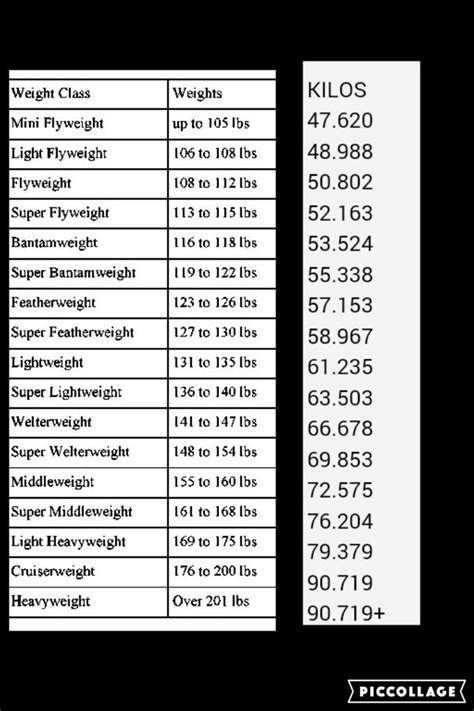Explore the significance of weight classes in boxing, their evolution, impact on strategy, safety, and key differences between professional and amateur divisions.Boxing is a sport that captivates fans with its intensity and skill, but many overlook a crucial element that shapes every match: weight classes. Understanding these divisions not only enhances your appreciation of the sport but also reveals the intricate strategies that fighters employ. In this article, we delve into the importance of weight classes in boxing, exploring their historical evolution and the differences between professional and amateur formats. We will also discuss how these classes impact fighters’ strategies, tactics, and safety inside the ring. Whether you’re a seasoned boxing fan or a newcomer to the sport, grasping the nuances of weight classes is essential for a deeper understanding of what makes each bout unique. Join us as we navigate the world of boxing weight classes and their significant role in shaping the sport.
Understanding The Importance Of Weight Classes In Boxing
The concept of weight classes in boxing is vital for ensuring fair competition among fighters. By categorizing boxers based on their weight, the sport seeks to prevent mismatches that could lead to serious injury or unfair advantages. Understanding the significance of these divisions can provide insights into how they influence the sport’s dynamics.
One of the primary purposes of weight classes is to promote safety within the sport. When fighters compete against opponents of similar sizes, the risks associated with physical confrontations are minimized. This not only protects the fighters but also enhances the overall integrity and respect for the sport.
Moreover, weight classes help maintain competitive balance. Adjusting tactics, techniques, and training regimens are essential for fighters as they prepare for opponents within their specific weight range. For instance, a lighter fighter may rely on speed and agility, while a heavier competitor might focus on power and endurance. This strategic aspect enriches the boxing experience, making each bout unique depending on the fighters’ attributes.
In addition to safety and strategy, weight classes play a significant role in the business side of boxing. Promotions often create compelling matchups by pitting fighters from different weight categories against each other—thus appealing to diverse audiences and increasing viewership. The importance of this system cannot be overstated as it enhances the thrill of competition while maintaining a level playing field.
understanding the framework of weight classes is crucial for fans and aspiring boxers alike. It lays the foundation for healthier competition and fosters respect among participants, enhancing the sport’s legacy.
How Weight Classes Affect Fight Strategies And Tactics
In the realm of boxing, Understanding The dynamics of weight classes is crucial as they significantly influence fight strategies and tactics. Each weight class comes with its unique set of physical attributes, skill sets, and fighting styles that boxers must adapt to in order to succeed.
For instance, heavier fighters often possess more knockout power due to increased muscle mass and strength. This means that their fight strategy may pivot towards aggressive tactics that capitalize on their ability to land powerful punches. In contrast, lighter fighters may focus on speed and agility, employing strategies that emphasize movement, quick footwork, and evasion to outmaneuver their opponents.
The adjustment in fight tactics also extends to how fighters train for their bouts. A boxer in a lower weight class may dedicate more time to improving their stamina and speed, while those in heavier classes might concentrate on strength training and conditioning to effectively handle the rigors of facing a larger opponent.
Moreover, the psychological aspect of weight classes cannot be overlooked. The knowledge of opponent size, strength, and fighting style can influence a boxer’s confidence and preparedness. Understanding their own capabilities in relation to their opponent’s attributes can lead to strategic advantages, such as choosing to engage or avoid confrontation during specific periods of the fight.
Trainers play a pivotal role in shaping fight strategies that are tailored to the weight class. They analyze matchups meticulously to develop game plans that exploit weaknesses and counters in an opponent’s style while enhancing their fighter’s strengths. This strategic approach is essential for making calculated moves in the ring where every pound can matter significantly.
The History And Evolution Of Boxing Weight Classes
Understanding the history and evolution of boxing weight classes is crucial for appreciating the sport’s structure and safety measures. The concept of weight classes emerged as a response to the need for fairer competition among fighters of varying sizes. This systematic approach became essential in maintaining the integrity and safety of boxing matches.
Initially, boxing did not have formal weight classes. Early matches often saw fighters of vastly different weights competing against each other, leading to numerous injuries and an unfair advantage for larger fighters. The lack of regulations prompted significant reforms in the late 19th century.
The first official weight classes were established in 1909 by the National Sporting Club in London. The introduction of these classes marked a significant turning point in boxing, enabling fighters to compete against opponents with similar physiques. Here is a table that outlines some of the major milestones in the evolution of boxing weight classes:
| Year | Milestone |
|---|---|
| 1909 | Introduction of the first official weight classes by the National Sporting Club. |
| 1920s | International Boxing Federation (IBF) and World Boxing Association (WBA) began standardizing weight classes across the globe. |
| 1980s | Expansion of weight classes to include more divisions, accommodating a broader range of fighters. |
| 2000s | Complex regulations set by various boxing organizations led to the formal acknowledgment of over 17 weight classes. |
Over time, the evolution of weight classes has not only enhanced the sport’s competitiveness but also provided essential safety measures. Understanding the role these classes play allows fans and fighters alike to appreciate the significance behind each match and the necessity of fighting within a designated weight class. Today, boxing organizations continually evaluate and adjust these weight classes to ensure fairness and safety, reflecting the dynamic nature of the sport.
Key Differences Between Professional And Amateur Weight Classes
When it comes to boxing, understanding the distinctions between professional and amateur weight classes is crucial for fans, fighters, and trainers alike. While both formats aim to ensure fair competition and fighter safety, there are notable differences in how weight classes are defined and enforced.
| Aspect | Professional Boxing | Amateur Boxing |
|---|---|---|
| Weight Class Divisions | More diverse; includes title-specific classes | Fewer classes, generally standardized |
| Weigh-in Rules | Typically conducted the day before the fight | Must weigh in on the day of the fight |
| Weight Allowance | Usually offers a pound or two of leeway | No allowance; fighters must meet the exact class weight |
| Fighter Experience | Often experienced and seasoned fighters | Novices and amateur competitors |
| Regulatory Bodies | Multiple sanctioning bodies with varying rules | Standardized rules by national and international governing bodies (e.g., AIBA) |
The differences exemplified in the table highlight the variations in weighing protocol, divisions, and regulatory oversight that exist between professional and amateur boxing. Understanding these differences is important for anyone keen on comprehending the nuances of the sport.
Understanding The Impact Of Weight Classes On Fighter Safety
In the world of boxing, understanding the significance of weight classes transcends competitive fairness; it is also fundamentally linked to fighter safety. Weight classes are designed to ensure that athletes compete against opponents with similar body weights, significantly reducing the risks associated with mismatched fights. When fighters face opponents who are significantly larger or heavier, they may suffer from increased vulnerability to injuries, including concussion and severe physical trauma.
Researchers and boxing authorities acknowledge that the risk of injury can escalate when the weight differential is substantial. For instance, a lightweight competing against a heavyweight could potentially face life-threatening situations within the ring. A study conducted by sports health professionals highlights that a mere 10-pound difference can substantially increase the force of impact exchanged during a bout, potentially leading to greater instances of injuries.
| Weight Class | Maximum Weight | Typical Fighter Weight Range | Injury Risk Level |
|---|---|---|---|
| Flyweight | 112 lbs (51 kg) | 105-110 lbs | Low |
| Welterweight | 147 lbs (67 kg) | 140-145 lbs | Moderate |
| Middleweight | 160 lbs (73 kg) | 155-158 lbs | Higher |
| Heavyweight | 200+ lbs (90+ kg) | 195-210 lbs | Highest |
Furthermore, the implementation of weight classes plays a crucial role in maintaining a competitive environment where all athletes can participate safely. It promotes a more level playing field, emphasizing not only the physical skill and strategy but also the mental tactics employed by fighters based on their size and weight limits.
understanding the impact of weight classes on fighter safety is essential for anyone involved in the sport, from athletes and trainers to promoters and fans. By ensuring fair matchups, boxing can continue to be a thrilling yet safe sport that showcases the best of athleticism and strategy.
Frequently Asked Questions
What are the main weight classes in boxing?
The main weight classes in boxing include Heavyweight, Cruiserweight, Light Heavyweight, Super Middleweight, Middleweight, Super Welterweight, Welterweight, Super Lightweight, Lightweight, Super Featherweight, Featherweight, Super Bantamweight, Bantamweight, Super Flyweight, Flyweight, and Mini Flyweight.
How is the weight class determined for a boxer?
A boxer’s weight class is determined by their weight on the official weigh-in day, which is typically 24 hours before a fight. Each weight class has specific weight limits that a boxer must meet.
Why are weight classes important in boxing?
Weight classes are important in boxing to ensure fair competition, as they prevent larger, heavier boxers from fighting against significantly smaller opponents, which could lead to mismatched fights and increased risk of injury.
Can a boxer fight in different weight classes?
Yes, a boxer can fight in different weight classes, but they must adjust their weight to meet the requirements of the new class. Many boxers choose to move up or down in weight based on their training, conditioning, and strategy.
What happens if a boxer does not make weight?
If a boxer does not make the weight limit for their designated class during the weigh-in, they may be ineligible to fight, or the fight may be altered to a catchweight. Additionally, penalties such as fines or the loss of titles can apply.
How does moving between weight classes affect a boxer’s performance?
Moving between weight classes can affect a boxer’s performance in various ways. A boxer may gain strength and power by moving up, or they might improve speed and agility by moving down. However, these changes also come with risks and may require significant adjustments in training and nutrition.
Are there any titles associated with weight classes in boxing?
Yes, boxing titles are often contested within specific weight classes, sanctioned by different organizations like the WBC, WBA, IBF, and WBO. Each organization may have its own champion for each weight class, leading to multiple champions in similar divisions.









